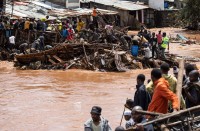Thousands fled from their homes as lava oozed out of a Mayon, a rumbling Philippine volcano on Monday, January 15, 2018, in what volcanologists described as a “quiet eruption”, warning it could lead to a hazardous explosion within days.
But what leads to volcanic eruptions?
Most of the world’s volcanoes are found around the Pacific Ocean’s Ring of Fire, a meeting point of tectonic plates and an area of intense seismic activity.
Tectonic plates are massive slabs of rock making up the Earth’s surface. Constantly moving on a hot bed of magma, volcanoes form in two ways at their boundaries.
Plates sometimes collide, causing one to slide beneath the other. This is called a destructive boundary.
Pressure and heat created by this movement forces magma up into cracks in the rocks until it explodes to the surface, as lava, causing a volcanic eruption.
Molten rock, debris and gases from the Earth’s interior are also emitted – either from the main crater or from secondary vents.
Plates can also move away from each other at so-called constructive boundaries.
In this case magma rises to fill the gap, creating a new crust. When this happens under the sea volcanic islands are eventually formed.
Volcanic activity can also occur underneath tectonic plates – in areas known as hot spots – when magma escapes through localized melted molten rock.
In terms of activity volcanoes are:
– Extinct, when they haven’t erupted for tens of thousands of years
– Dormant, when they are temporarily inert
– Active when they regularly churn out gas or lava
Sources: National Geographic, USGS







